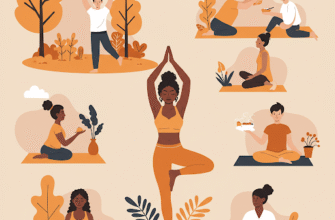Breathwork Techniques for Wellness
In today’s fast-paced world, stress and anxiety have become commonplace. Many people are searching for natural and effective ways to manage their mental and physical well-being. Breathwork, the conscious control and manipulation of breathing, has emerged as a powerful tool for achieving just that. It’s an ancient practice with roots in various cultures, and modern science is increasingly validating its benefits.
This article will delve into different breathwork techniques and explore how they can be incorporated into your daily life to promote wellness.
What is Breathwork?
Breathwork encompasses a wide range of techniques that focus on altering breathing patterns to influence mental, emotional, and physical states. It’s more than just taking a deep breath; it involves specific rhythms, depths, and patterns of breathing that can trigger different physiological responses in the body.
Breathwork techniques have been shown to reduce stress hormones like cortisol, lower blood pressure, and improve sleep quality. The positive impact on the nervous system is significant, shifting the body from a state of “fight or flight” to “rest and digest.”
Benefits of Breathwork
The advantages of incorporating breathwork into your routine are numerous and span various aspects of health:
- Stress Reduction: Breathwork activates the parasympathetic nervous system, promoting relaxation and reducing anxiety.
- Improved Sleep: Certain techniques can calm the mind and prepare the body for restful sleep.
- Enhanced Emotional Regulation: Breathwork can help process and release pent-up emotions.
- Increased Energy Levels: Some techniques can energize the body and improve focus.
- Pain Management: Breathwork can help manage chronic pain by reducing tension and promoting relaxation.
- Improved Cardiovascular Health: Certain techniques can lower blood pressure and improve heart rate variability.
- Enhanced Cognitive Function: Breathwork can improve focus, concentration, and memory.
Popular Breathwork Techniques
There are many different breathwork techniques, each with its own unique benefits. Here are a few of the most popular and effective ones:
Diaphragmatic Breathing (Belly Breathing)
This technique focuses on breathing deeply into the abdomen, allowing the diaphragm to expand and contract fully. It’s a foundational technique for relaxation and stress reduction.
How to practice:
- Lie down or sit comfortably.
- Place one hand on your chest and the other on your abdomen.
- Inhale slowly through your nose, allowing your abdomen to rise while keeping your chest relatively still.
- Exhale slowly through your mouth, allowing your abdomen to fall.
- Repeat for 5-10 minutes.
Diaphragmatic breathing is an excellent starting point for beginners. It’s simple to learn and can be practiced anywhere, anytime. Regular practice can significantly reduce anxiety and improve overall well-being.
4-7-8 Breathing
This technique, also known as the “relaxing breath,” is designed to calm the nervous system and promote sleep. It involves inhaling for a count of four, holding the breath for a count of seven, and exhaling for a count of eight.
How to practice:
- Sit comfortably with your back straight.
- Place the tip of your tongue against the ridge of tissue just behind your upper front teeth, and keep it there throughout the exercise.
- Exhale completely through your mouth, making a whooshing sound.
- Close your mouth and inhale quietly through your nose to a count of four.
- Hold your breath for a count of seven.
- Exhale completely through your mouth, making a whooshing sound, to a count of eight.
- Repeat the cycle at least four times.
Box Breathing (Square Breathing)
Box breathing is a simple yet powerful technique that can help regulate the nervous system, improve focus, and reduce stress. It involves inhaling, holding, exhaling, and holding again, each for the same amount of time, creating a “box” or “square” pattern.
How to practice:
- Sit comfortably with your back straight.
- Exhale completely.
- Inhale slowly and deeply through your nose to a count of four.
- Hold your breath for a count of four.
- Exhale slowly through your mouth to a count of four.
- Hold your breath again for a count of four.
- Repeat the cycle for several minutes.
Alternate Nostril Breathing (Nadi Shodhana Pranayama)
This technique, originating from yoga, is believed to balance the left and right hemispheres of the brain, promoting mental clarity and reducing anxiety.
How to practice:
- Sit comfortably with your back straight.
- Close your right nostril with your right thumb.
- Inhale deeply through your left nostril.
- Close your left nostril with your right ring finger and release your right thumb.
- Exhale through your right nostril.
- Inhale through your right nostril.
- Close your right nostril with your right thumb and release your left ring finger.
- Exhale through your left nostril.
- Continue alternating nostrils for several minutes.
Holotropic Breathwork
This is a more intense and advanced technique that involves rapid and deep breathing to induce altered states of consciousness. It’s typically done in a group setting with a trained facilitator.
Holotropic Breathwork is not suitable for everyone. It’s important to consult with a healthcare professional before trying this technique, especially if you have any underlying health conditions, such as cardiovascular problems, asthma, or a history of mental illness. This technique should only be practiced under the guidance of a certified practitioner.
Incorporating Breathwork into Your Daily Life
The beauty of breathwork is that it can be practiced anywhere, anytime. Here are some tips for incorporating it into your daily routine:
- Start small: Begin with just a few minutes of practice each day and gradually increase the duration as you become more comfortable.
- Find a quiet space: Choose a quiet and comfortable environment where you won’t be disturbed.
- Set a reminder: Use a timer or app to remind you to practice breathwork throughout the day.
- Practice regularly: Consistency is key to experiencing the full benefits of breathwork.
- Experiment with different techniques: Find the techniques that work best for you and that you enjoy practicing.
- Combine with other wellness practices: Integrate breathwork with other healthy habits, such as yoga, meditation, and exercise.
Choosing the Right Technique for You
With so many different breathwork techniques available, it can be challenging to know where to start. Consider your goals and needs when choosing a technique. If you’re looking for stress reduction, diaphragmatic breathing or 4-7-8 breathing might be a good starting point. If you’re seeking increased energy and focus, box breathing or alternate nostril breathing could be beneficial. For a more intense and transformative experience, consider exploring Holotropic Breathwork with a qualified facilitator.
It’s also important to listen to your body and pay attention to how you feel during and after practicing each technique. If a particular technique doesn’t feel right, don’t force it. Experiment with different techniques until you find the ones that resonate with you.
Resources for Learning More
There are many resources available to help you learn more about breathwork, including:
- Books: “Breath” by James Nestor, “The Healing Power of the Breath” by Richard P. Brown and Patricia L. Gerbarg.
- Online Courses: Websites like Udemy and Coursera offer a variety of breathwork courses.
- Apps: Apps like Calm, Headspace, and Insight Timer include guided breathwork exercises.
- Workshops and Retreats: Many yoga studios and wellness centers offer breathwork workshops and retreats.
- Certified Practitioners: Consider working with a certified breathwork practitioner for personalized guidance and support.
Breathwork is a powerful tool for promoting wellness and improving overall quality of life. By incorporating these techniques into your daily routine, you can reduce stress, improve sleep, enhance emotional regulation, and boost your overall well-being. Start exploring the different techniques and discover the transformative power of your breath.








